Journal list menu
Export Citations
Download PDFs
Cover Image
Organotopic organization of the primary Infrared Sensitive Nucleus (LTTD) in the western diamondback rattlesnake (Crotalus atrox)
- Page: Spc1
- First Published: 15 October 2014
Research Articles
Organotopic organization of the primary Infrared Sensitive Nucleus (LTTD) in the western diamondback rattlesnake (Crotalus atrox)
- Pages: 3943-3959
- First Published: 03 July 2014
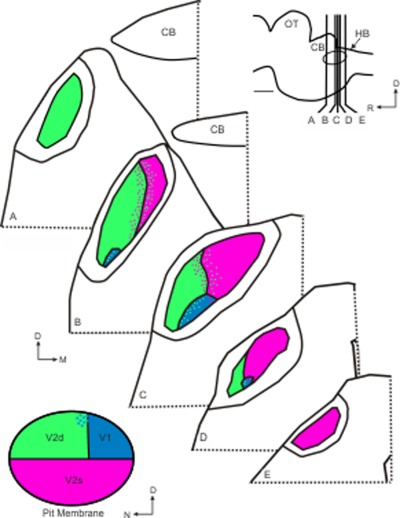
An in vitro whole-brain preparation of infrared-sensitive snakes was used to demonstrate the implementation of a topographical map at hierarchical levels of the signaling pathway from the sensory periphery to the first central nucleus in the hindbrain. The organotopic organization of environmental infrared cues is the likely anatomical prerequisite for the observed multimodal integration in the optic tectum.
Central pupillary light reflex circuits in the cat: I. The olivary pretectal nucleus
- Pages: 3960-3977
- First Published: 05 April 2014
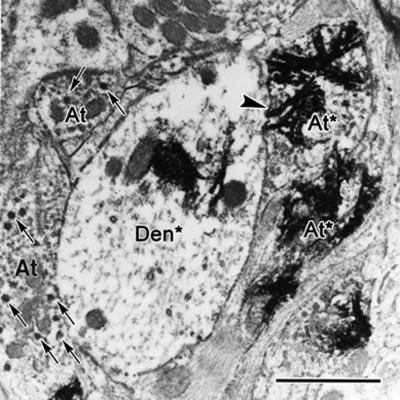
The central pathways subserving the feline pupillary light reflex were examined by defining retinal input to the olivary pretectal nucleus, its midbrain projections, and the premotor neurons within it. Labeled dendrites (Den*) of olivary neurons receive monosynaptic input (arrowhead) from anterogradely labeled retinal terminals (At*) and project to the anterior portion of the preganglionic motoneuron population. At, axonal terminal.
Central pupillary light reflex circuits in the cat: II. Morphology, ultrastructure, and inputs of preganglionic motoneurons
- Pages: 3978-4002
- First Published: 05 April 2014
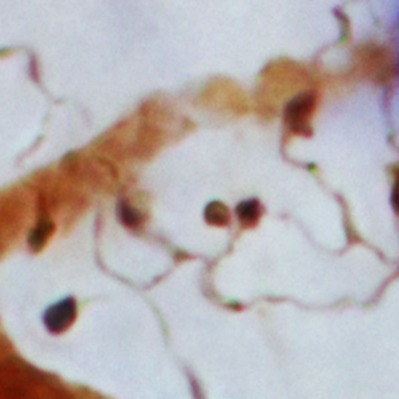
The preganglionic parasympathetic motoneurons controlling the pupil in the cat differ in distribution, morphology, and ultrastructure from those that control the lens. Fusiform pupillary motoneurons lie rostral to the oculomotor nucleus. Multipolar lens motoneurons lie dorsal and ventral to it. The former receive monosynaptic input (photomicrograph) from the olivary pretectal nucleus.
Exorhodopsin and melanopsin systems in the pineal complex and brain at early developmental stages of Atlantic halibut (Hippoglossus hippoglossus)
- Pages: 4003-4022
- First Published: 18 July 2014
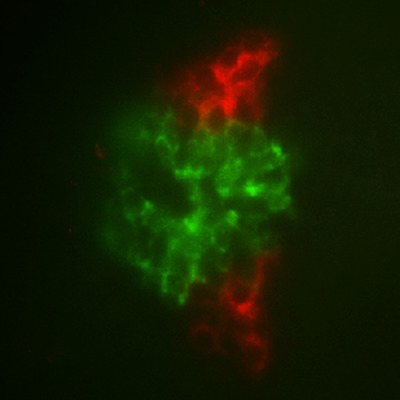
The authors describe an advanced nonvisual system in Atlantic halibut, prior to the development of functional eyes, with melanopsin-expressing cells in several brain regions and in spinal cord. In the pineal complex, melanopsin-positive cells are found lateral and adjacent to the central rosette of exorhodopsin photoreceptors.
Target- and input-dependent organization of AMPA and NMDA receptors in synaptic connections of the cochlear nucleus
- Pages: 4023-4042
- First Published: 19 July 2014
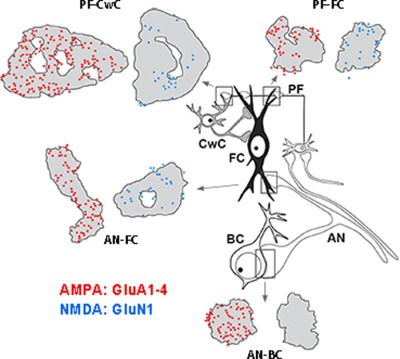
Using freeze-fracture immunogold labeling for AMPA and NMDA receptors at four distinct types of excitatory synapses in cochlear nucleus, authors reveal target- and input-dependent features in the structure, number, and organization of AMPA and NMDA receptors in auditory nerve and parallel fiber synapses.
Rat subthalamic nucleus and zona incerta share extensively overlapped representations of cortical functional territories
- Pages: 4043-4056
- First Published: 22 July 2014
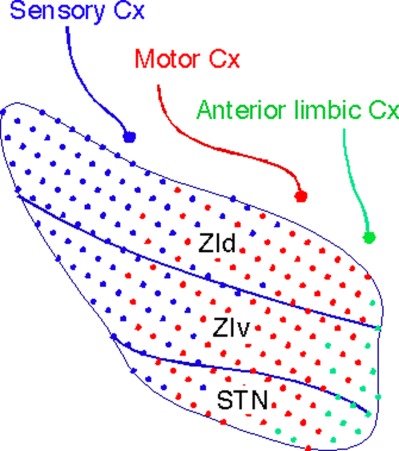
Lentivirus anterograde tracing study in the rat revealed that the subthalamus receives heavy projections from the motor and sensory cortices, the cortico-subthalamic projections have a large-scale functional organization that encompasses both the subthalamic nucleus (STN) and two subdivisions of the zona incerta (ZIv and ZId), and the group of cortical axons that originate from a particular area of Cx sequentially innervate and form separate terminal fields in the STN, ZIv, and ZId.
The sodium channel isoform transition at developing nodes of ranvier in the peripheral nervous system: Dependence on a Genetic program and myelination-induced cluster formation
- Pages: 4057-4073
- First Published: 22 July 2014
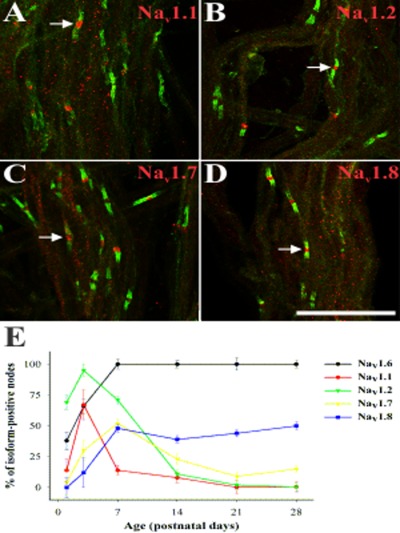
The authors show that developing myelinated nerves initially express a variety of sodium channel isoforms at nodes of Ranvier. This nonselective isoform expression is then developmentally eliminated by both neuronal and myelinating Schwann cell mechanisms, resulting in the selective expression of only the Nav1.6 isoform at nodes of mature nerves.
Regional and age-related differences in GAD67 expression of parvalbumin- and calbindin-expressing neurons in the rhesus macaque auditory midbrain and brainstem
- Pages: 4074-4084
- First Published: 04 August 2014
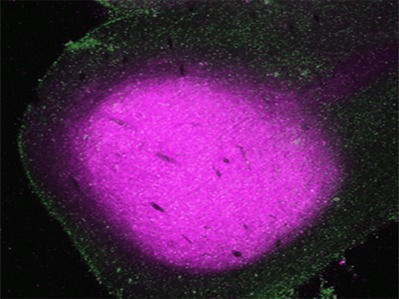
Throughout subcortical auditory structures, neurons expressing parvalbumin and calbindin change in density with age. In cerebral structures, these neurons are physiological inhibitors. This study demonstrates that in subcortical auditory structures of macaques only fractions of these neurons are GABAergic, so they are not analogous. Furthermore, these proportions show age-related changes.
Aberrant synaptic input to retinal ganglion cells varies with morphology in a mouse model of retinal degeneration
- Pages: 4085-4099
- First Published: 06 August 2014
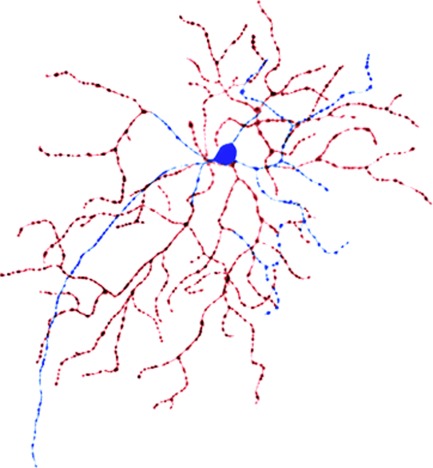
Using a combination of patch-clamp recordings and morphological measurements, the authors analyze the relationship between aberrant physiological activity and anatomical features of retinal ganglion cells in a mouse model of retinal degeneration. Cluster analysis reveals distinct groupings of cells, which correlate to the type and magnitude of oscillatory input.
Review
Endogenous versus exogenous markers of adult neurogenesis in canaries and other birds: Advantages and disadvantages
- Pages: 4100-4120
- First Published: 06 August 2014

Multiple endogenous markers can be used to analyze adult neurogenesis. This figure presents a schematic illustration of the different stages in the life of a neuron born in the adult brain and examples of the characteristic proteins expressed at these stages in the mammalian brain. Due to limitations in available antibodies and their specificity, only a fraction of these markers have been used and to some extent validated to study neurogenesis in the adult avian brain. These markers are highlighted in red in the figure.




